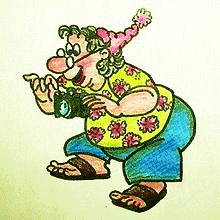Pea wondered when/if she should go schedule a mammogram. In order to answer her question and maybe someone else's inquiries, I checked with the
National Cancer Institute. Their comments are those within the quotes, mine are italicized.
I am not by any stretch an expert; but from what I understand, every woman from teens on should give herself an educated monthly exam; establish a base line for shape etc. I use my birth date each month to check, it's an easy date to remember.
"Getting a high-quality mammogram and having a clinical breast exam (an exam done by a health care provider) on a regular basis are the most effective ways to detect breast cancer early. Like any test, mammograms have both benefits and limitations. For example, some cancers cannot be detected by a mammogram, but may be found by breast examination.
Checking one’s own breasts for lumps or other unusual changes is called breast self-exam (BSE). Studies so far have not shown that BSE alone reduces the number of deaths from breast cancer. BSE should not take the place of routine clinical breast exams and mammograms."
At about 35 her doc should get involved on a yearly basis with a more thorough exam, more so than the regular exam you should be getting from your doc.At 40 you and your doc can begin to discuss mammograms and whether or not one is needed. Many times a doc will schedule one to get a base line image. If there is anything suspicious then there may be follow ups as regular as 6 months or yearly.
- "Women age 40 and older should have mammograms every 1 to 2 years.
- Women who are at higher than average risk of breast cancer should talk with their health care providers about whether to have mammograms before age 40 and how often to have them.
The risk of breast cancer increases gradually as a woman gets older. However, the risk of developing breast cancer is not the same for all women. Research has shown that the following factors increase a woman’s chance of developing this disease:
- Personal history of breast cancer—Women who have had breast cancer are more likely to develop a second breast cancer.
- Family history—A woman’s chance of developing breast cancer increases if her mother, sister, and/or daughter have a history of breast cancer (especially if they were diagnosed before age 50).
- Certain breast changes on biopsy—A diagnosis of atypical hyperplasia (a noncancerous condition in which cells have abnormal features and are increased in number) or lobular carcinoma in situ (LCIS) (abnormal cells found in the lobules of the breast) increases a woman’s risk of breast cancer. Women who have had two or more breast biopsies for other benign conditions also have an increased chance of developing breast cancer. This increased risk is due to the condition that led to the biopsy, and not to the biopsy itself.
- Genetic alterations (changes)—Specific alterations in certain genes (BRCA1, BRCA2, and others) increase the risk of breast cancer. These alterations are rare; they are estimated to account for no more than 10 percent of all breast cancers.
- Reproductive and menstrual history —Women who began having periods before age 12 or went through menopause after age 55 are at an increased risk of developing breast cancer. Women who have their first child after age 30 or who never have a child are at an increased risk of developing breast cancer.
- Long-term use of menopausal hormone therapy—Women who use combination estrogen-progestin menopausal hormone therapy for more than 5 years have an increased chance of developing breast cancer.
- Breast density —Breasts appear dense on a mammogram if they contain many glands and ligaments (called dense tissue), and do not have much fatty tissue. Because breast cancers tend to develop in the dense tissue of the breast (not in the fatty tissue), those older women whose mammograms show more dense tissue are at an increased risk of breast cancer. Abnormalities in dense breasts can be more difficult to detect on a mammogram.
- Radiation therapy ("x-ray therapy")—Women who had radiation therapy to the chest (including the breasts) before age 30 are at an increased risk of developing breast cancer throughout their lives. This includes women treated for Hodgkin lymphoma. Studies show that the younger a woman was when she received her treatment, the higher her risk of developing breast cancer later in life.
- DES (diethylstilbestrol) —The drug DES was given to some pregnant women in the United States between 1940 and 1971. (It is no longer given to pregnant women.) Women who took DES during pregnancy may have a slightly increased risk of breast cancer. The possible effects on their daughters are under study.
- Body weight—Studies have found that the chance of getting breast cancer after menopause is higher in women who are overweight or obese.
- Physical activity level —Women who are physically inactive throughout life may have an increased risk of breast cancer. Being active may help reduce risk by preventing weight gain and obesity.
- Alcohol —Studies suggest that the more alcohol a woman drinks, the greater her risk of breast cancer.
- AND I am adding a rash, see the * below, this is extremely rare, but very DEADLY and hits young women, African American more than any others, but every time I see or hear anything about it, it has been a young white women, so it does happen. Check it.
- What are the chances that a woman in the United States might get breast cancer?
Age is the most important risk factor for breast cancer. The older a woman is, the greater her chance of developing breast cancer. Current rates suggest that 13.2 percent of women (or one in eight) born today will be diagnosed with breast cancer at some time in their lives. This statistic is based on population averages. However, the estimated chance of being diagnosed with breast cancer for specific age groups and for specific time periods may be a more informative way to consider breast cancer risk. Estimates of developing breast cancer in 10-year age intervals—as shown below—take into account that not all women live to older ages, when breast cancer risk becomes the greatest.
A woman’s chance of being diagnosed with breast cancer is:
| from ages 30 to 39. . . | 0.44 percent (often expressed as "1 in 229") |
| from ages 40 to 49. . . | 1.46 percent (often expressed as "1 in 68") |
| from ages 50 to 59. . . | 2.73 percent (often expressed as "1 in 37 ") |
| from ages 60 to 69. . . | 3.82 percent (often expressed as "1 in 26 ") |
Most breast cancers occur in women over the age of 50. The number of cases is especially high for women over age 60. Breast cancer is relatively uncommon in women under age 40.
*There is also a lesser known breast cancer that isn't lump, but rather Inflammatory Breast Cancer or a rash; which is extremely deadly.
So ladies, unless you have a specific reason, such as one of those listed above, you shouldn't need to worry about any thing more than self exams until you are well into your forties.
However, we should all be in the habit of monthly exams, even if we don't fall into any of the marker or high risk groups.
WE NEED TO KNOW OUR BREASTS! If anything seems different form one month to the next get it checked out.




















2 comments:
Thanks for reminding me how important it is to do a monthly exam. Most of the time I forget or think I will do it 'tomorrow'. Using the day you were born is a clever tool to remember to do it every month!
DCG, I am so terrible about remembering things that I give myself reminder days! Anything "personal" is done on my b-day, and then, for instance the day before the rubbish is picked up I make sure to de-clutter all the rooms in my house. Hey whatever gets the job done!
Post a Comment